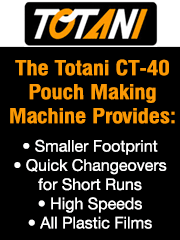Electronic Ink Technology: New Players Aid Progress
- Published: September 01, 2001, By Richard M. Podhajny, Ph.D., Contributing Editor
Not only will these “electronic inks” be used on paper, but they can be printed and laminated to create many packaging products.
More than a year ago, I offered our readers a look at a revolutionary technology called “E Ink.” This month I will update you on the progress of this technology.
E Ink, founded in 1997 and headquartered in Cambridge, MA, was spun out of work conducted at the Massachusetts Inst. of Technology.
The technology involves micro encapsulation of charged particles suspended in a nonconducting liquid. The particles in one configuration of the development are white and black but have opposite charges.
When an appropriate electric field is applied to the microcapsules, the particles move to or from the applied electric field. White particles can move in one direction, while the black particles or black liquid can create the black image. The result is a dark image against a white background.
These micro encapsulations are applied as ink or coating onto a substrate that is laminated with a layer of circuitry. The circuitry can form patterns. In many ways, it is similar to the liquid crystal display that is used on your dashboard. However, there are major differences. Among these differences: Once the image is formed, it does not need a power source to be maintained.
A major obstacle was how to produce an electronic grid that would have the required density for high quality graphics. Now Lucent Technology has joined E Ink as a partner, bringing a key component to the potential success of the technology: the ability to print tiny transistors that could solve this problem.
More recently, Philips Components, a div. of Philips Electronics of The Netherlands, has formed an agreement with E Ink to produce high-resolution, active matrix electronic ink displays for use in smart hand-held devices. Under terms of the partnership, E Ink will develop and supply electronic ink films, which Philips will integrate with active matrix backplanes and custom electronics to produce display modules and subsystems. The first high-resolution electronic ink display prototype resulting from this partnership was demonstrated this past June.
In return for an equity investment and development assistance, Philips Components received the global rights to manufacture and sell hand-held display modules using E Ink films; and exclusivity on display modules for certain applications, including personal digital assistants (PDAs) and electronic books.
In addition to Lucent Technologies and Philips Components, investors in E Ink include Motorola Corp, The Hearst Corp., Dugussa-Hels, and Creavis GmbH. E Ink is a privately held company and is not currently traded under any exchanges.
E Ink's development of this technology is expected to be challenged by such companies as Xerox, which has a similar technology called “Gyricon.” Like E Ink, Gyricon can be used as an electronic reusable paper for books and display materials. This new technology is somewhat like electrostatic liquid toners in that it uses charged particles in a nonconducting medium. In Gyricon's technology, beads that are “bichromal” are used with hemispheres of two contrasting colors (e.g., black and white, red and white); they are charged so they exhibit an electric dipole. These beads are contained in oil-filled cavities and are free to rotate within the cavity. When voltage is applied to the surface sheet, the beads rotate to present one colored side. Voltages can be applied to the surface to create images for text and pictures.
As of this writing, E Ink has had limited commercial exposure. While Xerox's Gyricon still is being developed, it is expected to provide competition for E Ink.
While these technologies are not developed fully, they illustrate the technical possibilities that undoubtedly will affect printing as we know it. Not only will these “electronic inks” be used on paper, but they can be printed and laminated to create many packaging products.
You can take a look at these technologies by going to these web sites: www.EInk.com and www.parc.xeron.com.
Dr. Richard M. Podhajny has been in the packaging and printing industry for more than 30 years. Contact him at 215/616-6314, e-mail: rpodhajny@colorcon.com.













